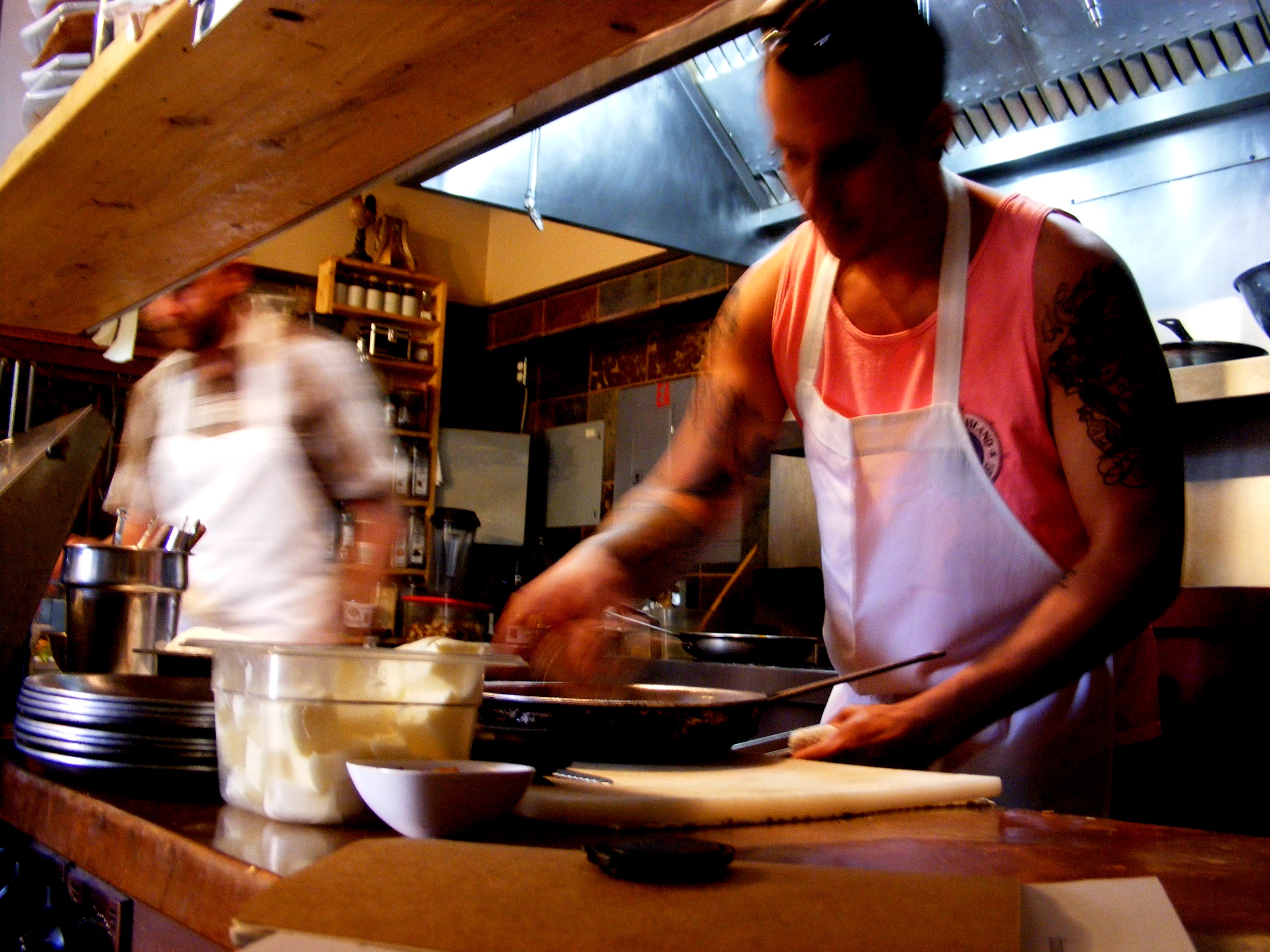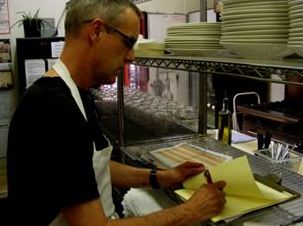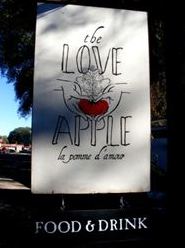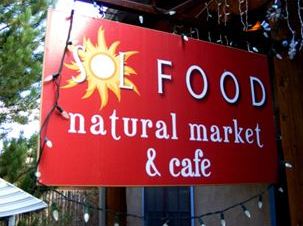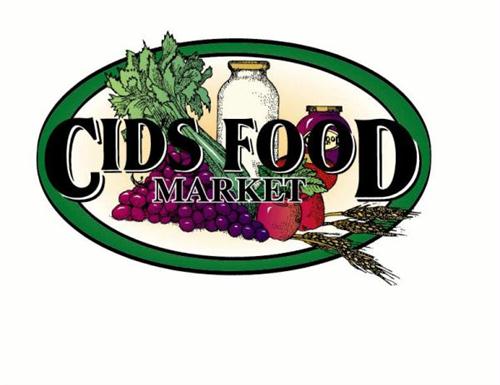Heading into the 21st century, there’s a widening gap in differing styles of restaurants. On the one hand, there’s what we’ll refer to as a “traditional” style of restaurant: one whose primary focus is on taste and portions. They seek to offer more “bang for the buck,” as well as please the public palate, in the process satiating the American need for specific flavor profiles, e.g., sweet, spicy, and salty. The majority of their food comes from a can or is otherwise packaged. Said food is delivered via a major distribution company that operates on a statewide and national level. Their ubiquity affords them the opportunity to offer their products at bargain-basement prices to their clients, who in turn can, purportedly, pass the savings on to the consumer.
The second type of restaurant falls under the emerging “Farm to Table” style of restaurant. Here, the emphasis is on fresh and local. The majority of foodstuffs come from gardens and farms in the vicinity straight to the kitchen. Attempting to wean themselves from national distributors, they seek to close the circle of production and distribution in on themselves, in the process, reinforcing the local economy and instituting a distribution cycle that seeks to keep revenue within the community. The basic difference can tentatively be couched as a “quantity vs. quality” argument: the former style of restaurant offering the quantity, the latter, quality.
In regard to food, bigger is not always better. Oftentimes, the “quantity” style of restaurant touts their humble origins as a folksy way of serving the local populace and offering common taste and value. They’re built on the constant supply of inexpensive, processed foods that are generally acquired outside their region. They view the latter “quality” driven restaurants as an extravagance, a model that caters to a particular socioeconomic portion of the community, which, particularly here in northern New Mexico, plays well, as the majority of the populace barely manages to get by.
The problem with this argument is it further enforces the divide between socioeconomic classes, leaving no opportunity for growth from the former to the latter. This dependency on mass-produced, processed products reinforces a mode of economics that may seem a “traditional” way of doing things, but is in fact a fairly recent construct. Formulated in the early- to mid-twentieth century, it has distribution of goods at its core and is dependent on fossil fuels in order to operate. It has created a dependency on the “fast & cheap” ethos that is at the heart of “fast food,” and has been effective in creating a false sense of entitlement to these products from a populace that’s become overly-dependent on their all-pervading presence across our landscape.
The Restaurant business is not for the faint of heart. The profit margins can be razor-thin, and the work a daily battle (the kitchen doesn’t operate on the brigade system for nothing), yet there is an agreement that every Restaurant owner is entering into with the public when they open their doors. In fact, the basis of hospitality is an implicit agreement between restaurant and consumer, wherein each will do something for the other — not to the other, i.e., customer behaves, and doesn’t dump their personal problems or ego trips on the staff, and the staff delivers prompt, courteous service, without dumping their trips on the consumer. When farm to table is introduced into the quotient, the stakes are raised — the qualitative shift bearing an idealistic component that comes with a hefty price tag. Across the board it means a cost increase. Most consumers know this, as attested to in the rise of Whole Foods: it’s much more expensive, but it’s accepted as long as what you get reflects the impulse.
However, following the maxim that “all good things must come to an end,” we’ve come to realize that this “fast and furious” way of consumption is rapidly going the way of the dinosaur; this, due more to the un-sustainability of the endeavor than lack of support. Prior to the invention of this juggernaut, “farm to table” (for lack of a better term) ruled the day. Without the all-important distribution element at hand, food was produced in a natural way, with the factors of freshness and accessibility being paramount. Fast food created the belief there’s no end to the supply of inexpensive, accessible food for those in need. It made us forget food comes from the Earth, and there’s a limit to that supply.
It can’t keep up with the demand. The cornerstone of economics that relies on supply has been propped up on the crutch referred to as “science” or “progress” since the industrial revolution. In its recent manifestation are genetically modified foods meant to trick Mother Nature into producing more, but as we used to know . . . you can’t fool Mother Nature.
Not only does Earth tell us this, but our own bodies do as well. Processed foods have often been shown to be one of the root causes leading to cancers, high-blood pressure, and obesity — among other maladies. Aside from these egregious effects, these foods don’t provide important nutritional components that allow the brain to operate at a level commensurate with what’s needed to perform at high levels — a fact particularly important in the developmental stages of a child’s life. Perhaps it’s no coincidence the past twenty years have witnessed a drastic rise in mental health issues such as ADHD, bi-polar disorder and Autism. It’s not too hard to connect the dots . . .
The predilection Advertising has in steering consumers to fast and processed foods for “healthy” reasons such as “low fat and cholesterol,” are misleading, and completely disregard the crucial factors of sustainability of production, not to mention the aforementioned health risks. To recapitulate: the media is the major proponent in coercing consumers into buying processed food under the aegis of low cost, made possible by an untenable distribution and production model based on outdated means. The consequences of this style of consumption lie in affiliated medical and behavioral problems exacerbated by treating said problems with pharmaceuticals and soaring medical costs, which negate the “deal” one feels they’re getting when they choose fast, processed foods.
“We’ve never called ourselves a Farm-to-Table Restaurant. I think that name has been beaten to death. People are starting to abuse the term; people are latching on to it as a marketing principle. This collaboration with the farm wasn’t a political or moral decision, which is pretty nauseating. It was a decision about being a better restaurant and getting better product.”
— David Kinch, Chef/Owner of Manresa Restaurant
The first time I read the above quote from two-Michelin-starred Chef David Kinch, I must admit I felt a bit offended. It seemed he was ignoring the natural growth process that occurs with any “new” concept. In order for the message to have complete saturation at all socioeconomic levels, it needs be tweaked to get its foot in the door, so to speak. Granted, adulteration of said concept can be a slippery slope, but if it is to be incorporated into the public consciousness, it needs start from the bottom.
Farm to table promises to be healthy, nutritious, and otherwise qualitatively better food. It originally meant a sort of complete transparency, as it were, a way for the consumer concerned with nutrition and personal and planetary health to be assured that what’s on their plate is a reflection of their ideals and concerns. Kinch’s dislike of the statement is warranted, as I can attest to personally as a Restaurant Professional, witnessing first-hand how the term is stretched to its limits by businesses built on being billed as “fine-dining,” or “upscale.” In Kinch’s case, he claims to be solely concerned with having Manresa be the best restaurant it can be, and to that end he’s done his due diligence. The James Beard Foundation Award-Winning Chef has been awarded two Michelin stars for five consecutive years. He works exclusively with, and has made nearby Love Apple Farms his personal farm. The farm uses biodynamic and organic practices, and is a sustainable wonder. The ensuing product is a memorable dining experience enjoyed by an elite group of diners that share his pursuit for the “best” in dining.
It’s all fine and dandy for them. Manresa is in the Santa Cruz Mountains, in Silicon Valley environs. For a majority of their clientele, price is no object. Yet, in a way Kinch’s form of farm to table becomes just another bourgeois affectation. The qualitative argument that farm to table deserves can’t take root in the public consciousness without first-hand knowledge. The majority of diners won’t be able to experience it first-hand because they simply can’t afford it. Certainly, most Taoseños would consider it an extravagance.
“Seeds are a gift of nature and of diverse cultures. They are not a corporate invention. Passing on this ancient heritage from generation to generation is a human duty and responsibility.”
Currently, there is a cold war raging on the future of food on the planet. The future of Farming, the basis of food, is dependent on seeds and the soil into which they are planted. Both are under attack by multinational corporations that seek homogeneity across the board in taste and crops. All diners are potential voters. How we spend our dollars has a direct correlation to what’s produced. Extract our dollars from fast food and its suppliers and direct them towards businesses that honestly and diligently practice farm to table, and we strengthen not only our bodies and minds, but the local economy and the land on which we live.
When a restaurant or business advertises farm to table, yet only practices it selectively, they rob the cycle that it’s meant to be built upon, siphoning off dollars that belong to an already tenuous infrastructure. It’s High Noon in the restaurant world. The decisions facing us as consumers will affect our children, and their children, and so on . . .
As I’ve wandered northern New Mexico’s farms and queried its farmers, it’s consistently been brought to my attention that nobody’s getting rich. It’s ironic that most farmers can’t afford to eat in the establishments they sell to. The portion of the public that has inculcated the farm to table ethos into their lives to the extent they can sustain small local farms is so small it seems almost an exercise in futility. If our commitment level doesn’t meet theirs, the divide will be filled with an all-too-eager monolith of unsustainable products created by institutions intent on destroying life as we know it on earth to grow richer and more powerful. Yes . . . I just said it.
“Economists measure development in terms of increasing currency and material items, fostering greed. Politicians see development in terms of increased power, fostering hatred. Both measure the results strictly in terms of quantity, fostering delusion. From the Buddhist point of view, development must aim at the reduction of these three poisons, not their increase. We must develop our spirit. Cooperation is always better than competition.”
– Sulak Sivarkasa, Development As If People Mattered
Based on the above quote from Thai Buddhist and 1995 Right Livelihood Award winner, Sulak Sivarkasa, the following list takes into account not only those local restaurants that practice farm to table, but right relations in the community; as the way a restaurant treats their employees is important from an energetic level (why pay all that money for quality food to have the experience ruined by surly employees who are treated as second-class citizens by restaurant owners that want to be viewed as above reproach?). How we enjoy our food is also important.
The following list is by no means exhaustive, and is offered alphabetically to be democratic. To make the decision easier for you, dear reader, we’ve developed the following list of restaurants to make a clear distinction where one interested in supporting farm to table should spend their hard-earned money while here in Taos; whether the intrepid traveler or committed local, we wish you happy and healthy dining.
Imagine you’ve got a great friend that lives in a chic and well-designed spot in cozy downtown Arroyo Seco. Said friend is a great cook and uses only the best local products in his cosmopolitan-local menu. They’ve got great beer and wines to match any of the meat, fish, or vegetable dishes offered there. Being the spot of a good friend, it’s a laid-back atmosphere — not the sort of place one can expect a small army of well-trained Servers genuflecting about them . . . However, there’s a distinct feeling of simultaneous intimacy and community in the turquoise-blue interior, lowly lit in warm light. The price point is family-friendly and the food delicious across the board: perhaps the most accessible Restaurant on this list. Makes one feel as if they’re in Berkeley’s Gourmet Ghetto — the clincher: you’re really in Arroyo Seco! (to view our Edible Santa Fe post on Aceq, click here.)
Admittedly, El Meze is somewhat of an extravagance. This is not the sort of place to go looking for bargains. Still, it’s important as a watermark, a place that shows us what’s possible with beautiful ingredients. Chef Frederick Muller is a James Beard Award Nominee, and his imaginative fare rivals any big city restaurants in its presentation and quality. Service is attentive and impeccably timed — even the small details that other “high-end” local places miss (such as proper Wine Service for that $60 bottle) is available there. If you’re the local with the special occasion to celebrate, or the intrepid traveler with discerning tastes culled from meals across the globe that wants a special meal in a professional environment, this is the place.
Is somewhat of an anomaly… perhaps the most committed on this list to “farm to table,” the food always feels nutritious and fresh. As with the rest of Taos, Service is friendly and well-intentioned, yet potentially not as polished as others. Still, the restaurant has a true sense of self and can offer some of the best the area has to offer in well-prepared produce. The Love Apple can be that “game-changer” place, offering that “eureka” moment the “quantity” type diner might experience. It, like Aceq, has a sense of place that make them must visits for travelers that want to experience the best in town.

The newest on the list, Farmhouse has high aspirations for enriching the farm to table ethos in Taos; and with years of farming under her belt and a plot right next to the restaurant, owner Micah Roseberry is poised to make a splash in the sustainable dining world. Breakfast and lunch are currently being served with the possibility of dinner being added in the near future.
(see the latest Edible Santa Fe installment on Farmhouse here.)
Also in the quaint hamlet of Arroyo Seco, right across the driveway from Aceq, Sol Food Café is the perfect place to grab that lunch “to go” for that mountain picnic, or to just relax on their patio. Breakfast, grilled panini, salads, and wraps abound, all sourced from as close to home as possible. For the visitor that’s rented a house and has the desire to cook for themselves, the market carries fresh and local produce, organic grains, and regional specialties such as yak meat.
Locals have made Cid’s a success as a grocer, but the market also offers fresh and nutritious fare throughout the day from their salad bar and hot bar serving local tamales and breakfast burritos. The perfect spot to pull off the road and get a quick meal if you’re just passing through, or the place to shop if you’re in town for a few days, and as mentioned with Sol Market, want to cook for yourself.



